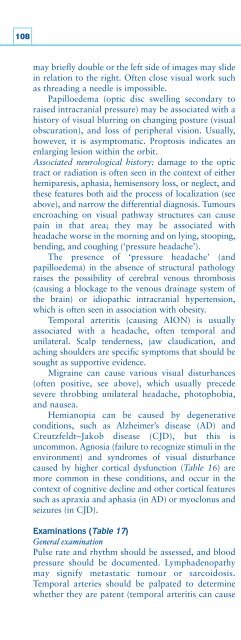Create successful ePaper yourself
Turn your PDF publications into a flip-book with our unique Google optimized e-Paper software.
108may briefly double or the left side of images may slidein relation to the right. Often close visual work suchas threading a needle is impossible.Papilloedema (optic disc swelling secondary toraised intracranial pressure) may be associated with ahistory of visual blurring on changing posture (visualobscuration), and loss of peripheral vision. Usually,however, it is asymptomatic. Proptosis indicates anenlarging lesion within the orbit.Associated neurological history: damage to the optictract or radiation is often seen in the context of eitherhemiparesis, aphasia, hemisensory loss, or neglect, andthese features both aid the process of localization (seeabove), and narrow the differential diagnosis. Tumoursencroaching on visual pathway structures can causepain in that area; they may be associated withheadache worse in the morning and on lying, stooping,bending, and coughing (‘pressure headache’).The presence of ‘pressure headache’ (andpapilloedema) in the absence of structural pathologyraises the possibility of cerebral venous thrombosis(causing a blockage to the venous drainage system ofthe brain) or idiopathic intracranial hypertension,which is often seen in association with obesity.Temporal arteritis (causing AION) is usuallyassociated with a headache, often temporal andunilateral. Scalp tenderness, jaw claudication, andaching shoulders are specific symptoms that should besought as supportive evidence.Migraine can cause various visual disturbances(often positive, see above), which usually precedesevere throbbing unilateral headache, photophobia,and nausea.Hemianopia can be caused by degenerativeconditions, such as Alzheimer’s disease (AD) andCreutzfeldt–Jakob disease (CJD), but this isuncommon. Agnosia (failure to recognize stimuli in theenvironment) and syndromes of visual disturbancecaused by higher cortical dysfunction (Table 16) aremore common in these conditions, and occur in thecontext of cognitive decline and other cortical featuressuch as apraxia and aphasia (in AD) or myoclonus andseizures (in CJD).Examinations (Table 17)General examinationPulse rate and rhythm should be assessed, and bloodpressure should be documented. Lymphadenopathymay signify metastatic tumour or sarcoidosis.Temporal arteries should be palpated to determinewhether they are patent (temporal arteritis can causeTable 16 Visual disturbance resulting fromhigher cortical dysfunctionAlexia without agraphia (able to write but not read)❏ Damage to connections between primary visualcortices and angular gyrus❏ Accompanied by right homonymous hemianopiaBalint’s syndrome❏ Gaze apraxia (inability to direct voluntary gaze)❏ Visual disorientation❏ Optic ataxia❏ Simultanagnosia (loss of panoramic vision)❏ Bilateral posterior watershed infarctionProsopagnosia (inability to recognize faces)❏ Bilateral inferior temporal lobe lesions❏ May have superior quadrantinopic defectsCentral achromatopsia (central colour vision loss)❏ Bilateral inferior temporal lobe lesions❏ May accompany prosopagnosiaAnton’s syndrome (blindness, but denial of blindness)❏ Normal pupillary response❏ Bilateral damage to occipital and parietal lobesTable 17 Examination for visual lossAssessmentGeneralOcularFundoscopyNeurologicalCranial nervesMotor nervesSensory systemExaminationPulse (rhythm, rate)Blood pressureLymphadenopathyTemporal arteriesProptosisPeriocular inflammationAnisocoria and pupillary responseVisual fieldsVisual acuityColour vision (Ishihara plates)Anterior chamberVenous pulsation and vesselsOptic discRetinaMaculaOcular movementsLateralized weaknessReflexesPlantar responsesVibration and position sense testingLateralized pain and temperature lossSensory inattention and corticalsensory loss
















